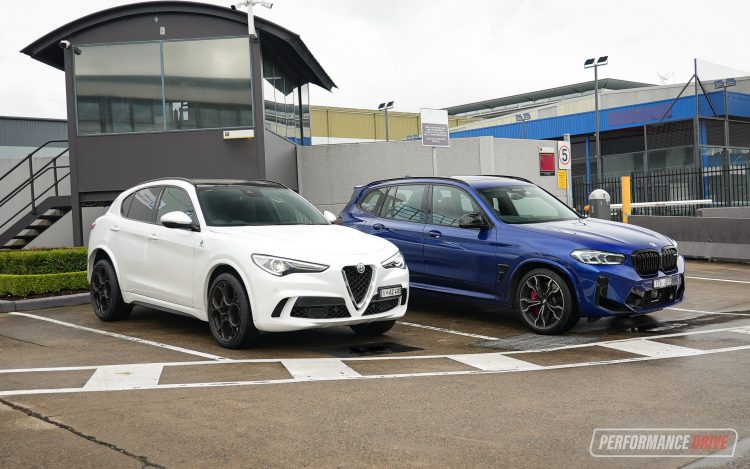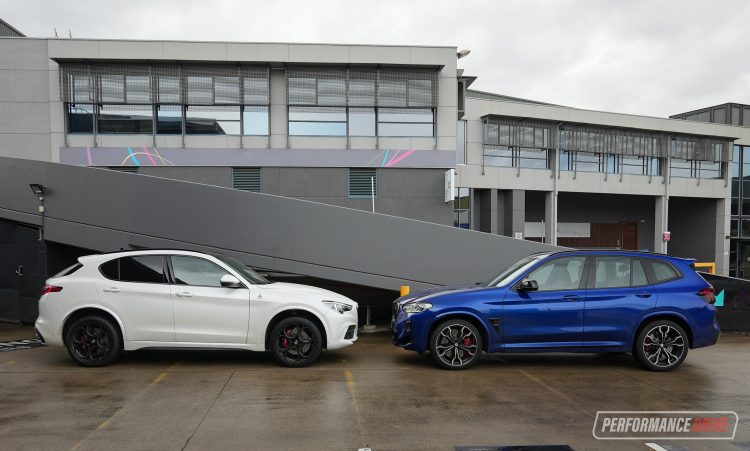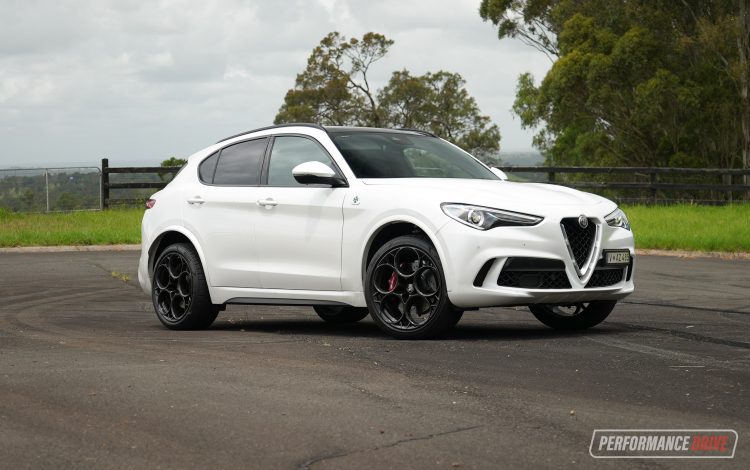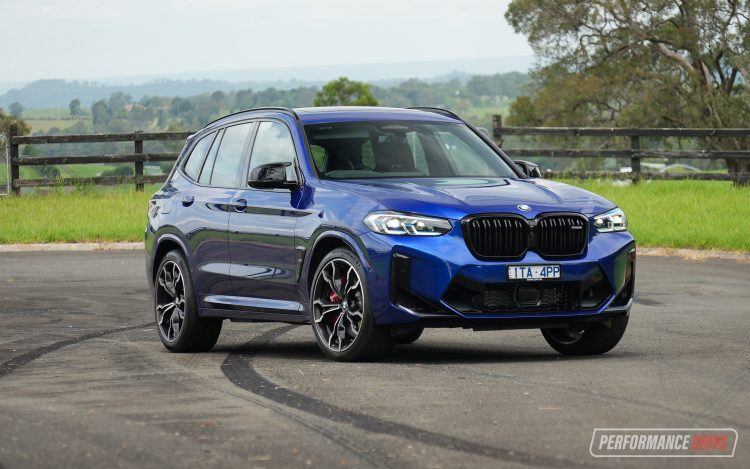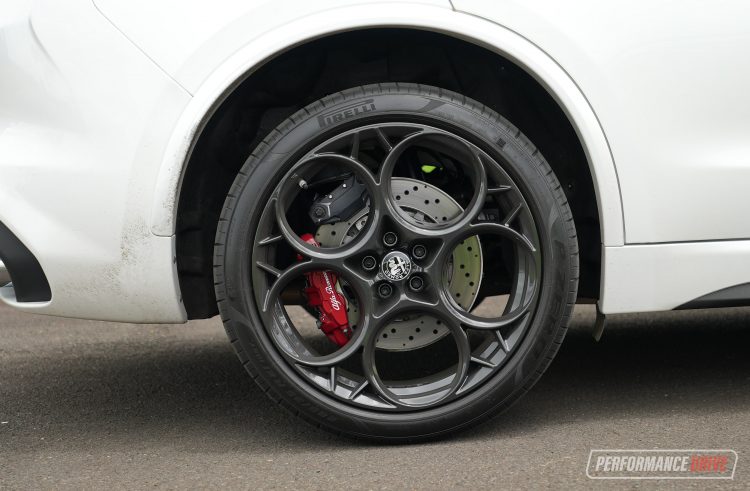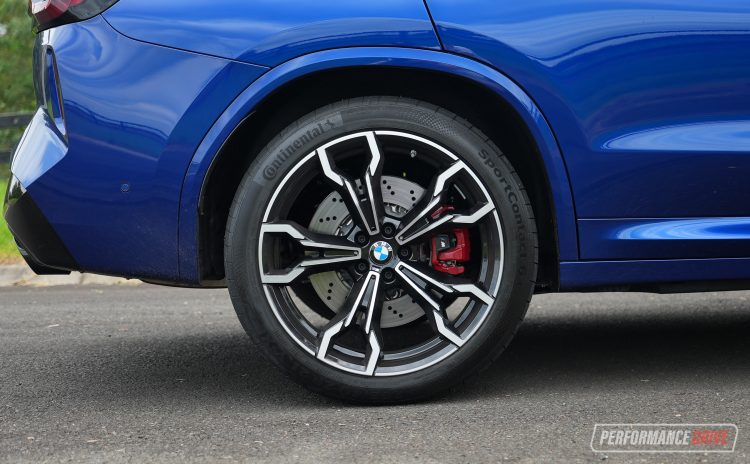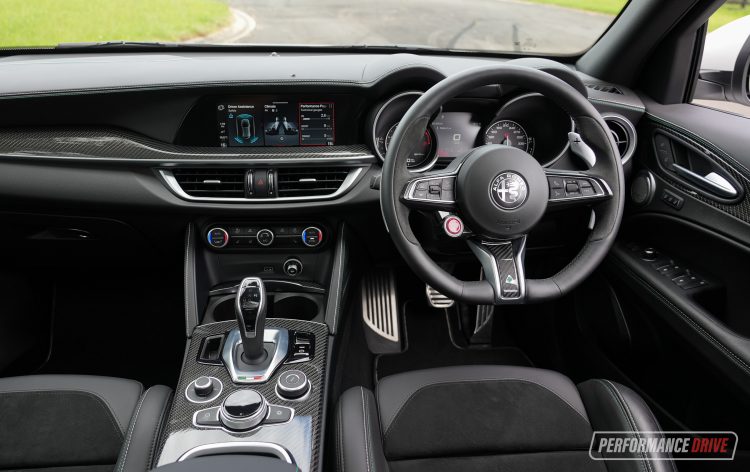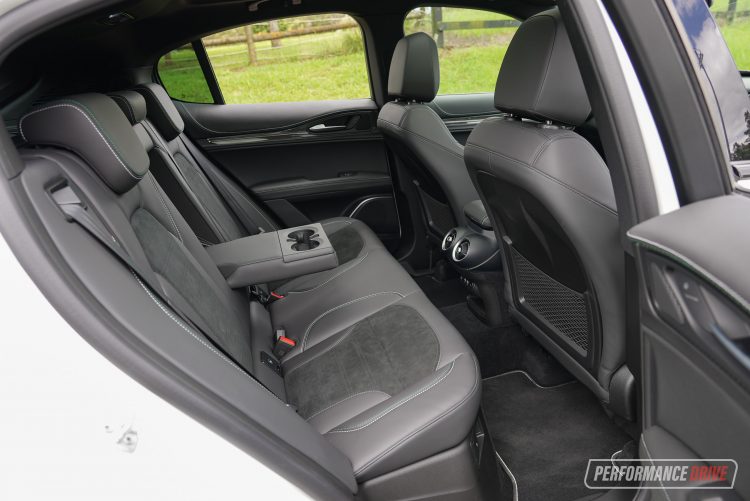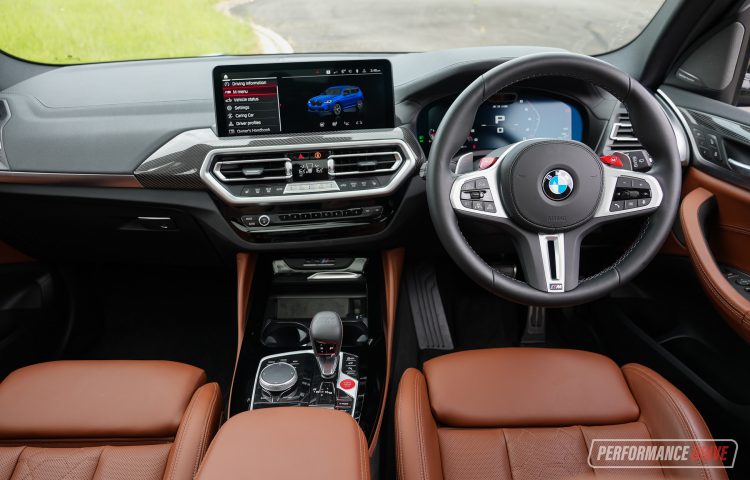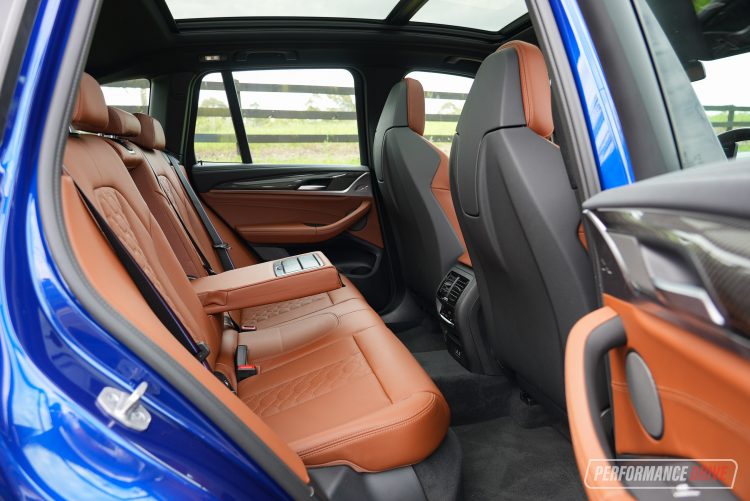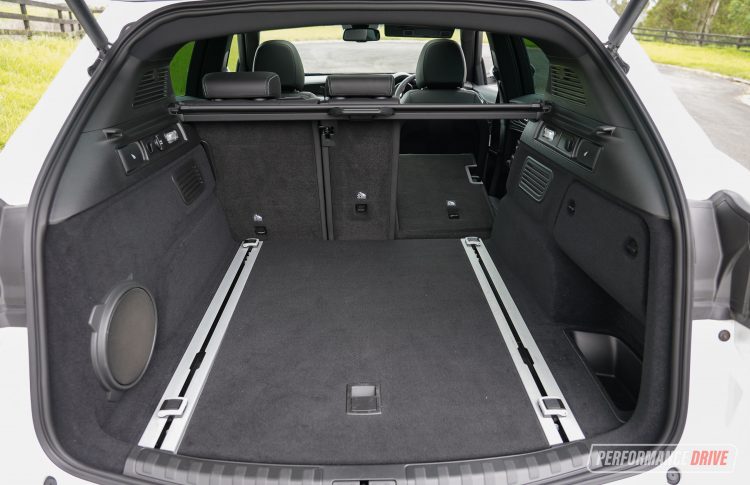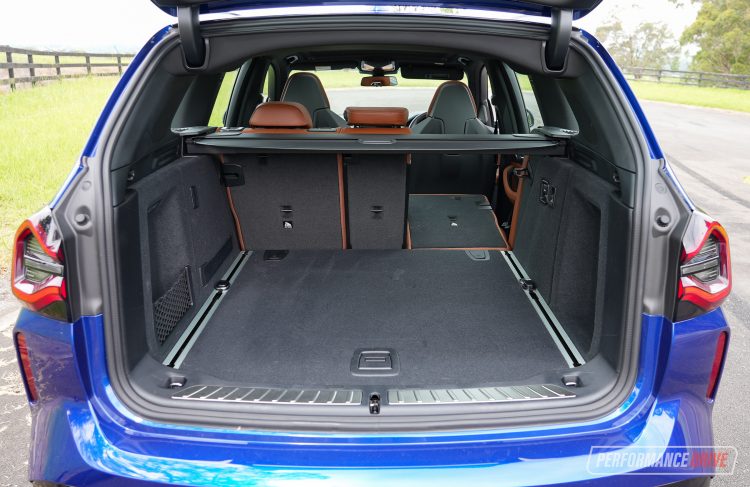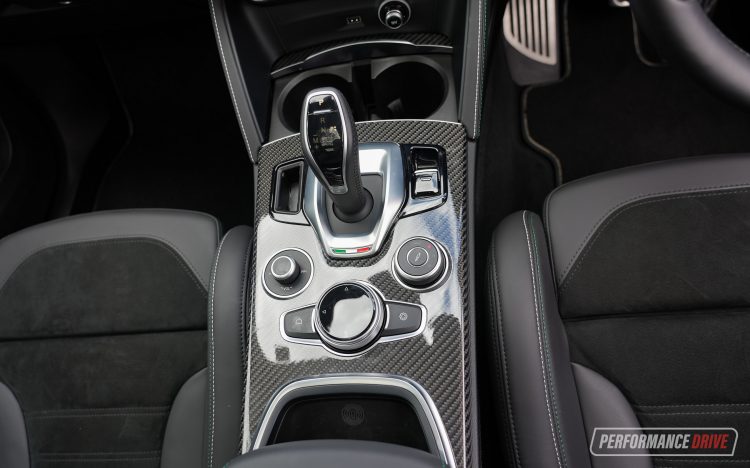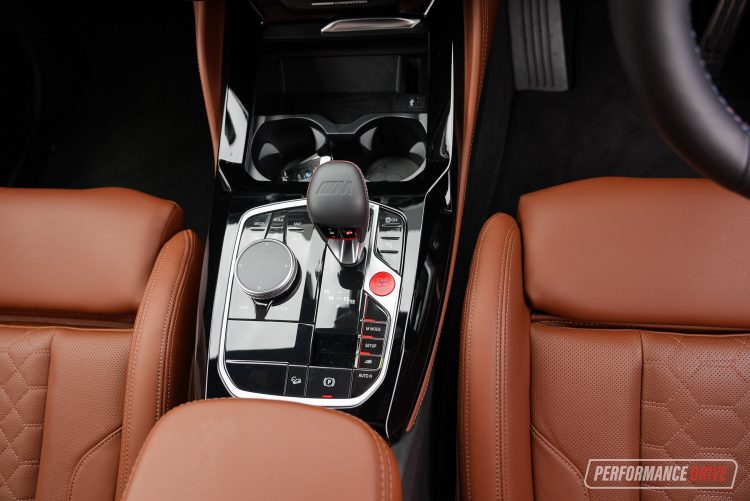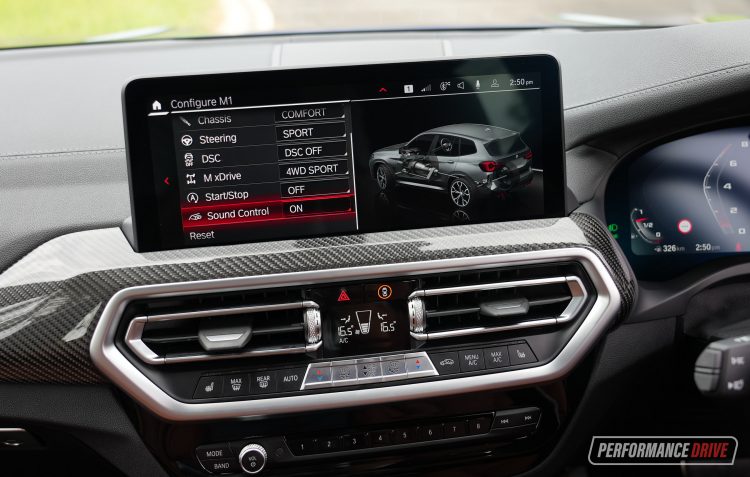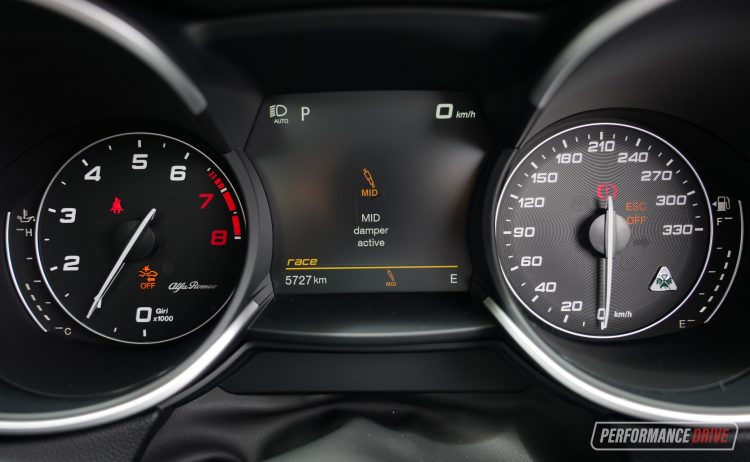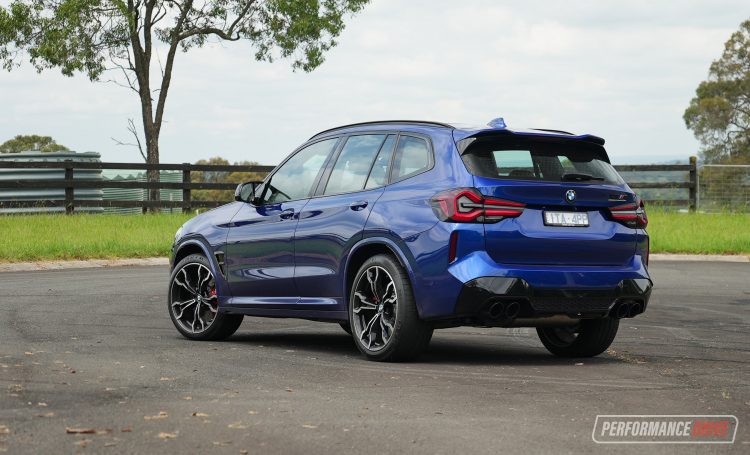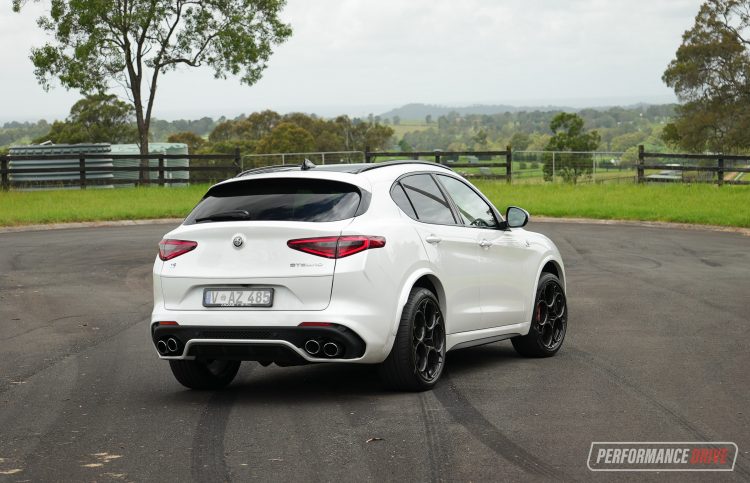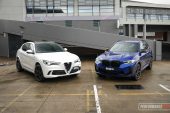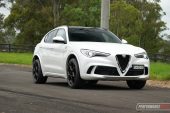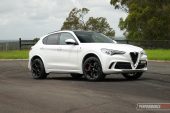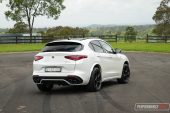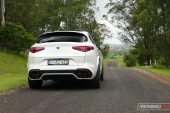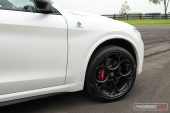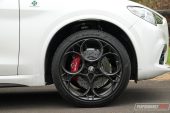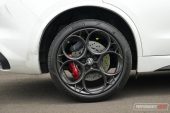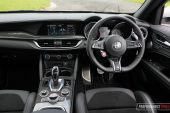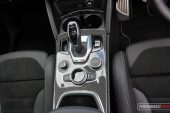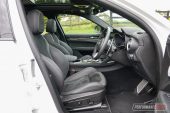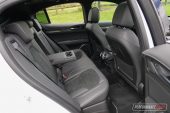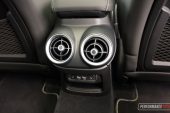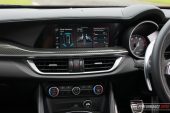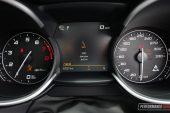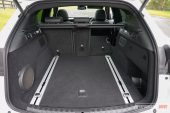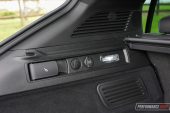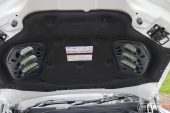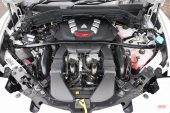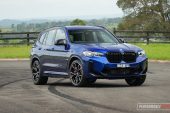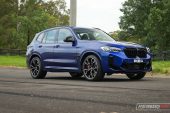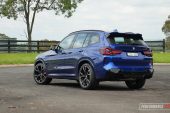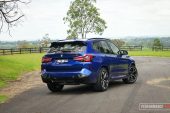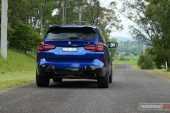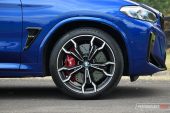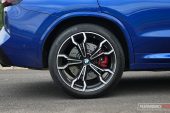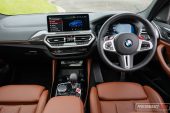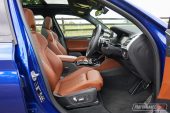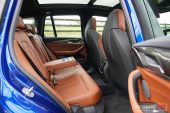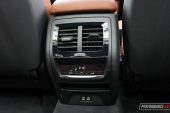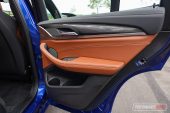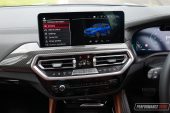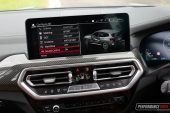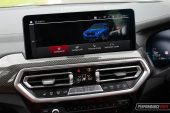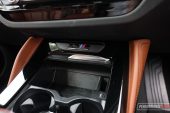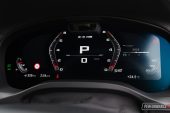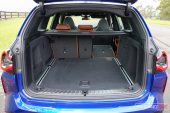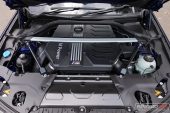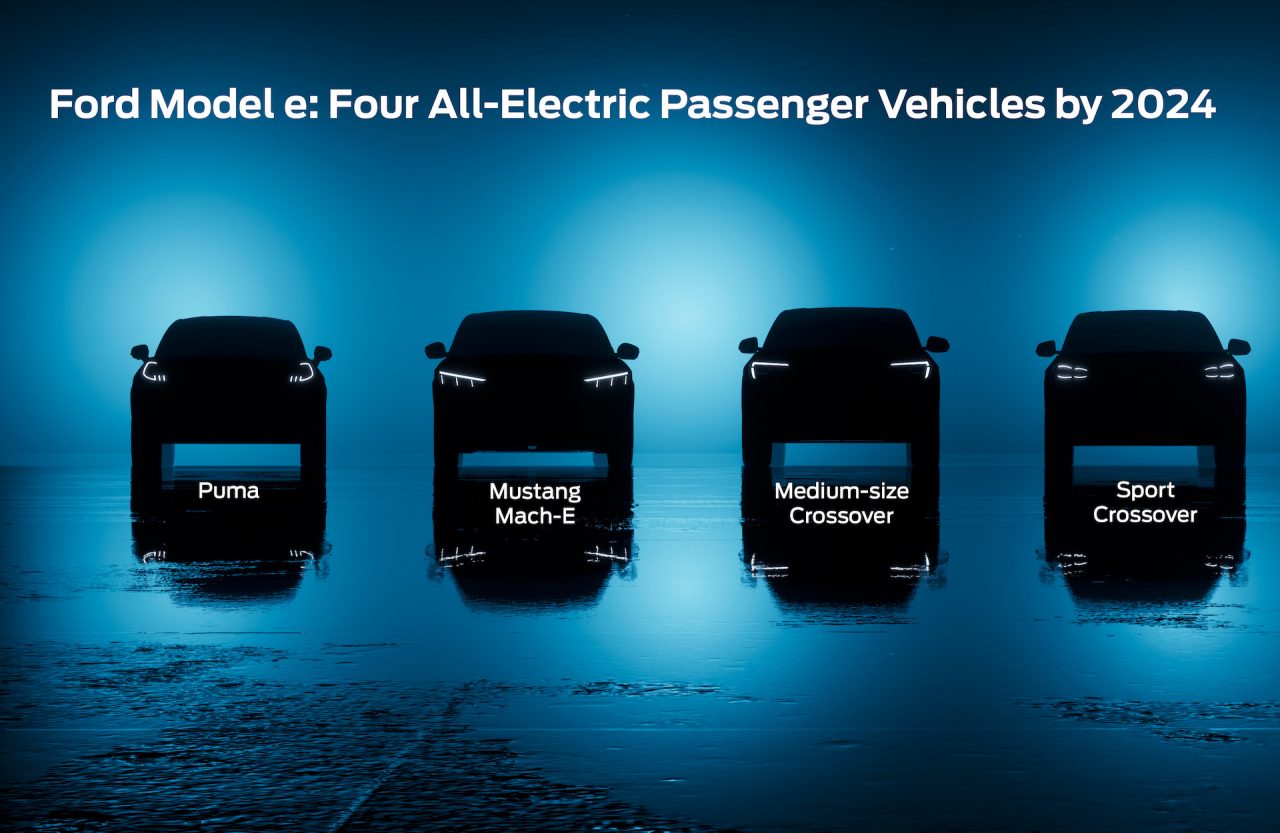In the market for a fast yet practical high-performance mid-size SUV? Either the recently-announced 2022 BMW X3 M Competition or the Alfa Romeo Stelvio Quadrifoglio are a great place to start. They both feature a potent twin-turbo six-cylinder engine offering reasonable economy and outstanding performance, and they both offer proper everyday usability and functionality. And all with very little compromise. So which is the best option for you?
The Stelvio Quadrifoglio (we’ll call it the QV from here purely to save time) was one of the pioneers of this class, remembering it set a Nurburgring lap record for a production SUV in its day (with a time of 7:51). Of course, the Mercedes-AMG GLC 63 has been on the market since around 2015 as well, or 2017 in Australia as the GLC 63 S. It features a blunt-force-brute twin-turbo V8 developing 375kW and 700Nm. It is the most expensive option in this class, and is at the end of its lifecycle.
The Merc is priced from $178,824, while the 2022 BMW X3 M Competition starts from $160,471. These make the Alfa look like an absolute bargain, as it is priced from $147,950 (all excluding on-roads). That’s essentially a $30,000 and $12,000 saving, respectively, for something that promises an identical result.
2022 Alfa Romeo Stelvio Quadrifoglio – THE SPECS
[column width=”47%” padding=”6%”]Engine: 2.9-litre twin-turbo V6
Output: 375kW@6500rpm / 600Nm@2500-5000rpm
Transmission: Eight-speed auto
Drive type: All-wheel drive, active rear differential
Wheels: F: 20×9.0, 255/45 R: 20×10, 285/40
ANCAP: Not tested (regular Stelvio 5 stars)
Tare weight: 1790kg
Power-to-weight: 4.77:1 (kg:kW)
Official fuel economy: 10.2L/100km
Economy during test: 12.9L/100km[/column] [column width=”47%” padding=”0″]Fuel capacity/Type: 64L/98 RON
Power efficiency: 36.76kW:L/100km
0-60km/h: 2.36 seconds*
0-100km/h: 4.33 seconds*
0-200km/h: 14.77 seconds*
60-110km/h: 2.59 seconds*
1/4 mile: 12.52 seconds at 186.1km/h*
Max acceleration: 1.086g
100-0km/h braking: 2.84 seconds at 35.96 metres*
Max deceleration: -1.431g
Decibel at idle (/Race mode): 46/53*
Peak decibel at 60-100km/h: 93*
Priced from: $147,950[/column][end_columns]
2022 BMW X3 M Competition – THE SPECS
[column width=”47%” padding=”6%”]Engine: 3.0-litre twin-turbo inline-six
Output: 375kW@6250rpm / 650Nm@2750-5500rpm
Transmission: Eight-speed auto
Drive type: All-wheel drive, active rear differential
Wheels: F: 21×9.5, 255/40 R: 21×10, 265/40
ANCAP: Not tested (regular X3 5 stars)
Tare weight: 1968kg
Power-to-weight: 5.24:1 (kg:kW)
Official fuel economy: 10.7L/100km
Economy during test: 12.5L/100km[/column] [column width=”47%” padding=”0″]Fuel capacity/Type: 65L/98 RON
Power efficiency: 35.04kW:L/100km
0-60km/h: 2.03 seconds*
0-100km/h: 4.03 seconds*
0-200km/h: 13.78 seconds*
60-110km/h: 2.62 seconds*
1/4 mile: 12.16 seconds at 188.5km/h*
Max acceleration: 1.102g
100-0km/h braking: 2.74 seconds at 34.56 metres*
Max deceleration: -1.468g
Decibel at idle (Sport Plus mode): 42/46*
Peak decibel at 60-100km/h: 91*
Priced from: $160,471[/column][end_columns]
* Figures as tested by PerformanceDrive on the day. Factory claims may be different
2022 Alfa Romeo Stelvio Quadrifoglio vs BMW X3 M Competition – THE PACKAGE
Starting with the Alfa Romeo. The Stelvio has been on the market now for a few years with no major change. But despite that, it remains a very competitive proposition. In terms of driving dynamics, thrills, value, and outright performance.
The Italians obviously know a thing or two about styling. This looks both muscular and seductive, with its fat wheels sticking out wide to provide a firm stance on the road. In our opinion, the wheels can look a bit odd within the guards from some angles, as if they are an aftermarket fit that’s not quite right. There is a lot of gap between the tyre and the arch, too. More than usual.
Other than that, the QV does look pretty similar to the regular Stelvio. You need to look a bit closer to see the front and rear bumper bars are unique, and various trimmings are bespoke to the QV. An extra lip is given to the wheel arches to help envelop those big wheels, for example. As standard you get a set of traditional-design 20-inch forged alloy wheels, or you can option up to 21-inch ‘QV’ forged rims as shown here. They’re wrapped in Pirelli P-Zero tyres measuring 255/40 on the front and a whopping 285/35 on the back.
Underneath it all is the Giorgio platform as seen underpinning the Giulia sedan. In fact, this top-spec QV variant shares the same twin-turbo powertrain as the Giulia QV. Except this features all-wheel drive compared with the Giulia’s rear-drive setup. Like the Giulia, the Stelvio features an electronic steering and braking system, which can feel quite touchy at first. But we’ll get to the driving later.
BMW gave the X3 a facelift last year, including the X3 M Competition. In our view, the X3 has never really stood out with styling. But it’s clear to see BMW has tried to spice things up a bit with this new model. The front end now incorporates more attitude, with a cheeky big grin highlighted in black, and there are some new intakes to help charge the engine and cooling system. And how good is this deep blue paintwork, called Marina Bay Blue.
Some new-look dark-tinted taillights are applied to the rear for the 2022 model as well, and of course underneath is BMW’s widely-used CLAR platform, shared with everything from the 3 Series to the 7 Series – albeit revised to suit. Like the Alfa, X3 M features all-wheel drive with an active rear diff.
BMW has gone for a different approach with wheel and tyre sizes compared with the Alfa. Here we have 21-inch wheels, with 255/40 front tyres and only slightly wider 265/40 rear tyres. This, to us, suggests the X3 has been set up to offer a decent degree of play and flexibility in handling. BMW has chosen Continental Sport Contact 6 rubber.
Overall the X3 does seem to blend in with the crowd more than the Alfa. Just in terms of overall design. It still has hints of aggression and a few clues that there is something very serious going on underneath, but it doesn’t look as exclusive or as special as the Stelvio in our opinion. But then again, subtlety has always been a hallmark of M’s philosophy. In this comparison though we have to give the flamboyant Italian the win. It’s almost law.
Inside we have two different approaches of the same formula. The Stelvio’s dash flows elegantly across the cabin, with discreet green stitching signifying its heritage. There’s a relatively new sports steering wheel which was applied with an update in 2020, as well as a newish 8.8-inch touch-screen.
We find the touch-screen to be a bit basic by today’s standards, in terms of sheer clarity and graphics, but there are plenty of fun menus and functions to play around with. Android Auto and Apple CarPlay come standard, along with a 14-speaker sound system, digital radio, and heated front and rear seats. Speaking of which, the front seats are awesome, providing excellent grabbing support, and we like the suede inner-sections which tend to breathe compared with straight leather.
Back seat passengers are supported by cool aviation-style climate vents that are completely adjustable, and there are a couple of USB charging ports below. In terms of space, the Alfa does seem more cramped than the X3, especially in the back. But it could be a perception thing as those climate vents sprout right out in the centre. The doorway is definitely tighter however, including for head clearance.
Get your sunglasses out because this is one vivid interior package in the Beemer. This test car shows off the no-cost optional Tartufo leather trim, which is named after an Italian ice-cream dessert. Aside from the dazzling colour, we think this interior is more resolved and more sophisticated overall. It also seems better made, with fewer creaks and squeaks to report, and more of the materials are of higher quality; proper metal (or metal-like) trims on the dash and console, more refined buttons and switchgear, and a cool digital screen for the climate control.
The typical BMW dash design isn’t the fanciest, but in this comparison the huge 12.3-inch touch-screen does present clearer graphics and is easier to use thanks to the iDrive hand controller. Android and Apple connectivity are offered as well, with a superior 16-speaker sound system as standard. It also showcases a crisp surround-view parking camera system, easily bettering the standard (and pretty ordinary quality) rear-view camera on the Stelvio.
The fully digital instrument cluster also provides some changeable display themes, and although we usually prefer finely-crafted analogue dials, the screen in the BMW does look better than the fairly basic gauges in the Stelvio.
These front seats in the BMW really wrap you in, and they offer heaps of adjustment, including extendable under-thigh pads. Again, you’ll find subtle blue and red stitching in various areas to pay respect to the brand’s heritage. Unlike the Stelvio, wireless phone changing is an optional extra on the X3.
Although the rear seat area doesn’t look as stylish as the Alfa’s presentation, it is more practical. You have big door pockets, climate control settings, and twin USB-C charging ports. The centre seat position does offer more room as well, with a lower driveline tunnel allowing for reasonable legroom.
Being SUVs, both of these offer excellent cargo-carrying capability. You could easily use either as a daily driver, in other words. Whether that’s picking up the shopping or doing the school run. Both come with a 12-volt socket in the back, but only the Alfa features pull-tabs in the wall to fold down the rear seats. They both offer some under-floor storage.
In terms of on-paper specs, the BMW edges ahead with 550 litres of boot volume, defeating 525L in the Alfa. However, both present 1600 litres when the rear seats are folded down.
2022 Alfa Romeo Stelvio Quadrifoglio vs BMW X3 M Competition – THE DRIVE
As for the engines? Well, they are, again, different approaches to the same formula. The Alfa features a Ferrari-developed 2.9-litre twin-turbo V6, producing 375kW and 600Nm. Peak power is hit at 6500rpm, while torque is spread over a 2500rpm window, between 2500-5000rpm.
Over in the BMW, it’s a 3.0-litre twin-turbo inline-six. It produces the same 375kW of power, but at 250rpm lower. Torque maxes out slightly higher, at 650Nm, and it is spread slightly wider in a 2750rpm window, between 2750-5500rpm.
How do they compare on the road? They both offer heaps of character, noise, and outstanding acceleration. We clocked 0-100km/h in 4.03 seconds in the BMW and 4.33 in the Alfa Romeo. Both brands claim the sprint can be achieved in 3.8 seconds. We also timed a best 0-200km/h of 13.78 seconds in the X3 and 14.77 in the Stelvio.
So, for the win, the X3 M is a little bit quicker in the real world. But the difference is so minute that you would have to be a driving genius to notice the variance. They both offer loads of low-down heave when churning through traffic, although the BMW seems more responsive in the default Comfort driving mode compared with the Alfa’s default mode.
Up through the gears the Alfa pops and bangs loudly in Dynamic mode, creating a very exciting drive experience. There is some jerkiness with the transmission at low speeds, despite featuring essentially the same ZF-based eight-speed auto as the BMW. We think the programming BMW has come up with is smoother and more intuitive, offering calmer changes at low speeds.
Another area that helps is the versatility of BMW’s driving modes. You have Comfort, Sport and Track, as well as a custom mode which allows you to mix and match different settings; with M1 and M2 preset buttons on the steering wheel. And there are lots of parameters to play around with, including transmission mapping, AWD characteristics, exhaust loudness, and steering and throttle response.
In the Alfa Romeo you get Dynamic, Neutral, and All-weather (similar to an eco mode). For really sporty drivers there is also a Race mode. However, this automatically turns the stability/traction control off, which is probably not ideal. Particular for those who want to experience a taste of the full performance but want the safety net just in case. Interestingly, you can select a softer suspension setting even in Race mode.
Neither of these two exhibit any handling characteristics that are suggestive of anything related to nervousness or insecurity. They are extremely stable, even when you ask them to do things that you’d expect from a serious sports car. We do like BMW’s steering over the Alfa’s setup, purely because it feels consistent and fluid. The Stelvio is very touchy but it does feel more mechanical and raw. For us though the sensitivity is too high.
As mentioned earlier, BMW M has gone for 255/40 front and 265/40 rear tyres. With narrower rear tyres than the Alfa, there is a higher potential for rear-based steering flexibility. You’re able to manipulate the cornering behaviour including managing and even provoking understeer and oversteer. Over in the Alfa, it is solid and predictable to a point, but always tracks straight and true.
Adding to this, the BMW’s front-to-rear track ratio is the opposite to the Alfa Romeo. The front track on the X3 M measures 1617mm with a narrower 1602mm at the back. On the Stelvio the front measures 1622mm with 1675mm at the rear. Again, this helps the BMW behave in a more flexible way. It might not be quicker around a circuit driving right at the limit, but the X3 does feel more forgiving and ‘friendly’ on the way to the limit, and even past it.
In terms of the overall driving experience, we prefer the BMW. It is more adjustable and versatile, with more modes and settings to play with, and it is quicker according to our Vbox. However, the Stelvio does offer favourably ride comfort in the default mode. Fuel economy is also slightly better in the Alfa, with an official average rating of 10.2L/100km over 10.7L/100km in the BMW.
We don’t really want to go into long-term reliability as we only tested these vehicles over a one-week period. Even so, FCA (owners of Alfa Romeo) hasn’t had the best reputation in this department over the years, often ranking quite low in those huge JD Power customer satisfaction surveys in the USA.
During our test this particular example did produces some funky engine sounds during cold starts, including a mechanical, tappet-like noise which went away after about a minute. Being a press vehicle, this example has probably endured lots of abuse in its time. The BMW did not exhibit any similar noises or concerns during our test.
2022 Alfa Romeo Stelvio Quadrifoglio vs BMW X3 M Competition – THE VIDEO
2022 Alfa Romeo Stelvio Quadrifoglio vs BMW X3 M Competition – THE VERDICT
These are both cracking machines and they prove just how versatile SUVs can be. You can use these every day with very little complaint. The Stelvio is clearly the most passionate of the two, with very sensitive steering and simpler drive modes. It also produces a more exciting exhaust note in our opinion.
As a modern SUV though the BMW wins. The larger touch-screen, quality interior and fit and finish, more practical rear seat, and the fact it is a bit quicker despite being around 200kg heavier (with the same power) makes it the pick in our books. But we can totally understand why some will choose the Alfa Romeo.
Better on the Alfa Romeo
– Stylish design
– More spirited and passionate engine, including exhaust note
– Sharper handling
– Standard wireless phone charger
Better on the BMW
– Superior 12.3-inch media screen and iDrive controller
– Higher quality interior
– Slightly bigger boot
– More adjustable handling, including versatile drive modes
– Quicker acceleration according to our Vbox tests
As always, if you’re thinking about buying a new car don’t forget to click here to speak with our car buying specialists.
